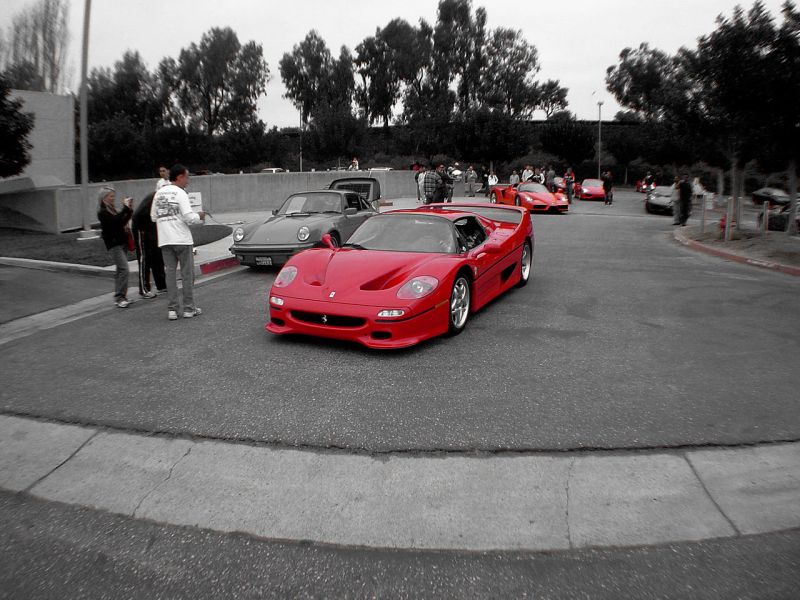
Being the halo car for a company like Ferrari comes with plenty of pressures and expectations all on its own. There have only been five such Ferrari models in the company’s history (as of this writing). The bar was set plenty high from the jump, beginning with the venerable 288 GTO in 1984. Then in 1987, Ferrari created the ultimate dream car, the F40, which adorned more teenagers’ walls than Cindy Crawford.
When the F40 retired in 1992, the world waited with bated breath and sky-high expectations for the next, latest, and greatest Ferrari. But when the F50 arrived on the scene in 1995, it was met with mixed reactions and quickly got unfairly labeled as the black sheep of the Prancing Horse family.

The successor to the Ferrari F40
The F40, with its dramatic lines and stunning good looks rivaled any Lamborghini or Porsche in the world, and it made such an intoxicating impact as one of the most incredible supercars in history that no matter what car came next, it was bound to be something of a letdown to the public for a number of reasons.
It may have been that the jump in evolution from the F40 to the F50 was not as significant as expected. Or because the F50 looked like an updated F40, it was inevitably bound to be compared to the car it embodied. Or, maybe because the F50 was the first halo car to be created after Enzo Ferrari’s passing garnered some unwarranted vitriol.
But, once removed from the shadow of the F40, and with the benefit of more than two decades of distance to reflect, it becomes quickly apparent that the Ferrari F50 deserves a massive amount of credit that it never got in its day.

The F50 makes 512 horsepower
Whereas the F40 used a twin-turbo 2.9-liter V-8, Ferrari chose a bigger 4.7-liter F1-inspired F130B V-12 to battle its rivals from Lamborghini and Porsche. Instead of using forced induction, the F50’s engine is naturally aspirated. Sporting an iron block, aluminum heads, five valves per cylinder, and a dry-sump lubrication setup, the F50 made an impressive 512 horsepower and 347 pound-feet of torque. Also worth noting is that, unlike its predecessor, the F50 was not hampered by bothersome rev-limiting turbochargers and thus could have its power peak come at a spine-tingling 8,500 rpm.
That power was routed through a tried-and-true 6-speed manual transmission and then onto the rear wheels. Unlike the later Enzo, which would use an automated manual or the even more futuristic LaFerrari, which used a dual-clutch automatic, the F50 is the last halo Ferrari to feature a clutch and shifter manual transmission.

The Ferrari F50 is a street-legal race car
As visually stunning as the F50 is, its styling is merely a product of its design. Its sleek body is a combination of exotic materials (for the ’90s, anyway) like carbon fiber, Kevlar, and Nomex honeycomb, which not only made the structure of the F50 incredibly stiff but also lightweight. Ferrari went so far as to install a rubber compound fuel cell to keep the F50’s curb weight down to a trim 2,712 pounds.
A predominantly aluminum suspension worked with a carbon fiber tub to keep things stiff even around the fastest corners. But one complaint about the F50, which proved valid, is that driving on anything except the smoothest and most desolate roads in the world was uncomfortable. Ferrari bypassed any metal subframes and bolted the V-12 directly to the tub, resulting in enough vibration to rattle the driver’s dental fillings.
The interior of the F50 also reflects its no-frills attitude toward luxury (or lack thereof). Aside from well-bolstered seats, the interior’s only real “highlight” is the aluminum 6-speed shifter and gate; unless you count HVAC vents or “F50” logo floor mats as features.
Some gave the F50 derogatory marks for its targa top-only style, insinuating that its open-air design somehow made it less of an actual race car. But, with no roof, it makes the absence of power windows much easier to deal with. ABS, power steering, and even power brakes didn’t make the final cut either, making the F50 about as hardcore as it gets, roof or no roof.

The Ferrari F50 is one of the fastest cars of the ’90s
Despite being criticized for many things, the F50 cannot be called out for being slow. The F50 is one of the fastest cars of its decade. Able to sprint from 0 to 60 mph in a scant 3.6 seconds and through the quarter-mile in a scalding fast 12.0 seconds at 126 mph, the F50 could hold its own against anything in the world during the ’90s and still not be embarrassed by the fastest cars in the world today. The F50 is also a member of the exclusive 200 mph club, capable of a 202 mph top end, putting it just behind a handful of extraordinary cars like the McLaren F1 and Jaguar XJ220.

The F50 Ferrari is skyrocketing in value
Since the F50 went out of production in 1997, appreciation for it has figuratively and literally grown exponentially over the years, which is the case for most Pininfarina-styled cars. Only 349 examples of the F50 ever drove off the assembly line, making it the second-rarest halo Ferrari ever made behind the 288 GTO, of which 272 got created. Much like today, Ferrari did a thorough background check on each potential customer, and in the case of the F50, each customer leased the car for a full two years before the title was handed over.
The Ferrari F50’s price, which initially came in at $475,000, now seems like a screaming bargain. Today, if you are lucky enough to find one of these magical cars, depending on mileage and condition, it could cost you anywhere from $2,000,000 to $4,000,000.



